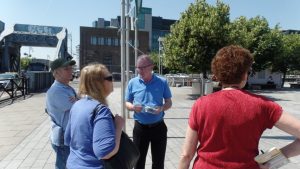We enjoyed another sumptuous breakfast similar to those at the other fine hotels on this trip. On the road, lunch is on our own – but Verle and I find that the breakfast carries us for the day, with just a snack, especially if supper is supplied as part of the tour, as it will be tonight at our hotel in Oxford.
We met our bus driver, Maria, for the next 4 days after a wait in front of the hotel with our bags. All England is watching today as England’s soccer team plays in the quarter finals competing for the World Cup.
Doug led us in a devotion on 1 Cor. 15:51 and we sang together “Oh God Our Help in Ages Past.” The day is expected to be hot so I wore shorts (85 or so – not hot like Nebraska, but it feels hot when we’re out in it.)
Our first stop was in Salisbury for a visit to the Salisbury Cathedral, built from 1220 to 1238. The builders of the Gothic church with flying buttress side supports claimed it to be “so great a church to the glory of God that those who come after us will think us mad even to have attempted it.”
This vibrant cathedral has Britain’s tallest spire (400 feet tall) and one of four surviving copies, the best preserved of the four, of the Magna Carter from 1707, considered the greatest constitutional document ever. This document provides for trial by jury, the opportunity to take even the government to court when a law is unfair, freedom of the church, and fair treatment in the application of justice. “Even a monarch must rule within the law.” Part of the original impetus for this document was the excessive demands and taxes of the tyrant, King John, after England’s war with France. After this document was adopted, Margaret Mead (1901-1978) observed that, “Never doubt that a small group of thoughtful, committed citizens can change the world. Indeed, it is the only thing that ever has.”Besides the beauty of the church and the Magna Carter, the delightful thing about our visit was the organ playing, the adults practicing, and the children’s choir singing Silent Night while we were there. Worship is held at the cathedral on every day of the week. A major repair program is being carried out, so much scaffolding is around one end of the church. The repair is being done using the traditional methods handed down over the centuries, employed by present day highly-skilled craftsmen.
Our other stop today was at Stonehenge, a wondrous sight, the Neolithic monument which dates to around 2800 B.C. (4500 year old structure) The bus took us part way out to the Heritage Site, and a shuttle bus took us the rest of the way. Then we walked on a trail all the way around the structure. They supplied us with phones that spoke to us at each posted number – this worked very well and was very informative. The sun was hot and I appreciated the red umbrella. Stonehenge’s builders used Pythagoras’ theorem 2000 years before Pythagoras’ discovery that the sum of squares of the two sides of a triangle will equal the square of the hypotenuse. Stones were brought by these early people from far away without the use of machinery of any kind. How did they do it? No one knows. Many theories exist as to the purpose of the site, but guesses are that it fit in with their religion, and perhaps they believed that special powers and healing powers existed at this site. People often think of our ancestors as rough cavemen, but the were also sophisticated astronomers. They were applying Pythagorean geometry over 2000 years before Pythagoras was born. Many, many burial mounds are found in a wide circle around Stonehenge. Archaeology on these sites continues to provide clues to help increase our knowledge about this archeological mystery.
Many of us took naps in the bus as we continued our drive to Oxford and our hotel there. Again, trees seemed to line both sides of the roadway most of the time, so there wasn’t much to see. As we approached Oxford, we drove through some forested area.
We had a very nice supper at the hotel and were all able to sit together around two round tables. Fun!
Crowne Plaza Heythrop Park – Oxford, Chipping Norton, UK 011-44 1608 673 333 www.ihg.com
Notes:
No tolls on England’s roads and bridges
Old Houses of chuda red brick or local stone
Rows of houses all alike
Buildings with massive chimneys with 1-4 or more vents each
Almost no billboards
No more than a light breeze this whole trip – no wind like in Nebraska
London people have second homes in the countryside.
Farms are larger than in Ireland, but they seldom have farmsteads.
Many buses ply the freeways, but we never see mobile homes or trailer houses.
Many very old homes, but still inhabited
Cameras control the highways and we almost never see a police car.
